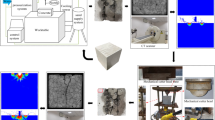Abstract
This paper presents experimental and theoretical methods to study the damage layer evolution of a breakwater made with concrete hollow squares in marine environment. Wetting time was directly related to the performance degradation of the breakwater by observation. The thickness of damage layer was detected by means of ultrasonic testing. Meanwhile, some samples drilled from concrete hollow squares were analyzed by SEM and XRD in order to illustrate the damage mechanism. Subsequently, a theoretical model containing wetting time ratio was established to simulate the damage layer evolution based on Fick’s second law, which could be suggested to predict the service life of concrete structures in marine environment.










Similar content being viewed by others
References
Liu PC. Damage to concrete structures in a marine environment. Mater Struct. 1991;24(4):302–7.
McCarthy MJ, Giannakou A. In-situ performance of CPF concrete in a coastal environment. Cem Concr Res. 2002;32(1):451–7.
Meira GR, Andrade C, Alonso C, Borba JC Jr, Padilha M Jr. Durability of concrete structures in marine atmosphere zones-the use of chloride deposition rate on the wet candle as an environmental indicator. Cem Concr Compos. 2010;32(4):427–35.
Safehian M, Ramezanianpour AA. Assessment of service life models for determination of chloride penetration into silica fume concrete in the severe marine environmental condition. Constr Build Mater. 2013;48:287–97.
Pradhan B. Corrosion behavior of steel reinforcement in concrete exposed to composite chloride-sulfate environment. Constr Build Mater. 2014;72:398–410.
Tennakoon C, Shayan A, Sanjayan JG, Xu A. Chloride ingress and steel corrosion in geopolymer concrete based on long term tests. Mater Des. 2017;116:287–99.
Yu HF, Da B, Ma HY, Zhu HW, Yu Q, Ye HM, Jing XS. Durability of concrete structures in tropical atoll environment. Ocean Eng. 2017;135:1–10.
Da B, Yu HF, Ma HY, Tan YS, Mi RJ, Dou XM. Chloride diffusion study of coral concrete in a marine environment. Constr Build Mater. 2016;123:47–58.
Zhang MH, Chen JK, Lv YF, Wang DJ, Ye J. Study on the expansion of concrete under attack of sulfate and sulfate-chloride ions. Constr Build Mater. 2013;39:26–32.
Müllauer W, Beddoe RE, Heinz D. Sulfate attack expansion mechanisms. Cem Concr Res. 2013;52:208–15.
Hu MY, Long FM, Tang MS. The thaumasite form of sulfate attack in concrete of Yongan Dam. Cem Concr Res. 2006;36:2006–8.
Ramezanianpour AM, Hooton RD. Thaumasite sulfate attack in Portland and Portland-limestone cement mortars exposed to sulfate solution. Constr Build Mater. 2013;40:162–73.
Santhanam M, Cohen MD, Olek J. Mechanism of sulfate attack: a fresh look part 1: summary of experimental results. Cem Concr Res. 2002;32(6):915–21.
Santhanam M, Cohen MD, Olek J. Mechanism of sulfate attack: a fresh look part 2: proposed mechanisms. Cem Concr Res. 2003;33(3):341–6.
Pack SW, Jung MS, Song HW, Kim SH, Ann KY. Prediction of time dependent chloride transport in concrete structures exposed to a marine environment. Cem Concr Res. 2010;40(2):302–12.
Chen JK, Jiang MQ. Long-term evolution of delayed ettringite and gypsum in Portland cement mortars under sulfate erosion. Constr Build Mater. 2009;23(2):812–6.
Lorente S, Yssorche-Cubaynes MP, Auger J. Sulfate transfer through concrete: migration and diffusion results. Cem Concr Compos. 2011;33(7):735–41.
Chen F, Gao JM, Qi B, Shen DM, Li LY. Degradation progress of concrete subject to combined sulfate-chloride attack under drying-wetting cycles and flexural loading. Constr Build Mater. 2017;151:164–71.
Chen YJ, Gao JM, Tang LP, Shen DM. Performance of concrete subjected to severe multiple actions of composite salts solution under wet-dry cycles and flexural loading in lab. J Wuhan Univ Technol Mater Sci Ed. 2017;32(4):1676–84.
Jiang L, Niu DT, Sun YZ, Fei QN. Ultrasonic testing and microscopic analysis on concrete under sulfate attack and cyclic environment. J Cent South Univ. 2014;21:4723–31.
Wang JB, Niu DT, Song ZP. Damage layer thickness and formation mechanism of shotcrete with and without steel fiber under sulfate corrosion of dry–wet cycles by ultrasound plane testing method. Constr Build Mater. 2016;123:346–56.
Oslakovic IS, Bjegovic D, Mikulic D. Evaluation of service life design models on concrete structures exposed to marine environment. Mater Struct. 2010;43:1397–412.
Zhu J, Jiang MQ, Chen JK. Equivalent model of expansion of cement mortar under sulphate erosion. Acta Mech Solida Sin. 2008;21(4):327–32.
Soiveab A, Tran VQ, Bouny VB. Requirements and possible simplifications for multi-ionic transport models—case of concrete subjected to wetting-drying cycles in marine environment. Constr Build Mater. 2018;164:799–808.
Zhang JR, Sun M, Hou DS, Li ZJ. External sulfate attack to reinforced concrete under drying–wetting cycles and loading condition: numerical simulation and experimental validation by ultrasonic array method. Constr Build Mater. 2017;139:365–73.
Zhang GZ, Ding QJ, Li DC, Sun DS. Analysis of microstructure of concretes utilized under marine environments. J Funct Mater. 2015;46(4):4107–12 (in Chinese).
Morandeau A, Thiéry M, Dangla P. Impact of accelerated carbonation on OPC cement paste blended with fly ash. Cem Concr Res. 2015;67:226–36.
Han J, Pan G, Sun W, Wang C, Cui D. Application of nanoindentation to investigate chemomechanical properties change of cement paste in the carbonation reaction. Sci China Technol Sci. 2012;55(3):616–22.
Collepardi M, Marcialis A, Turriziani R. Penetration of chloride ions into cement pastes and concretes. J Am Ceram Soc. 1972;55(10):534–5.
Tumidajski PJ, Chan GW, Philipose KE. An effective diffusivity for sulfate transport into concrete. Cem Concr Res. 1995;25(6):1159–63.
Bonakdar A, Mobasher B, Chawla N. Diffusivity and micro-hardness of blended cement materials exposed to external sulfate attack. Cem Concr Compos. 2012;34(1):76–85.
Acknowledgements
The authors would like to acknowledge the financial support by the National Natural Science Foundation of China (11832013, 11772164), the National Basic Research Program of China (973 Program, 2009CB623203), the Key Research Program of Society Development of Ningbo (2013C51007), and K.C. Wong Magna Fund in Ningbo University.
Author information
Authors and Affiliations
Corresponding author
Rights and permissions
About this article
Cite this article
Cang, S., Yang, Y. & Chen, J. Damage Layer Evolution of a Breakwater Under Seawater Attack: Testing and Modeling. Acta Mech. Solida Sin. 33, 1–13 (2020). https://doi.org/10.1007/s10338-019-00122-6
Received:
Revised:
Accepted:
Published:
Issue Date:
DOI: https://doi.org/10.1007/s10338-019-00122-6




